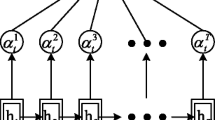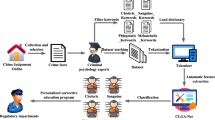Abstract
Traditional features and pipelined algorithms ignore the subspace semantic information and different information complementarity of regional bullying text when describing and recognizing regional bullying text. In order to solve the above problems, combined with features of Chinese, a regional bullying text recognition algorithm called Two-Branch Parallel Neural Network (TB-PNN) is proposed. First, the word vector, sentence vector, pinyin and tone features extracted by the word embedding technique and the character feature extracted by the Character Graph Convolutional Neural (CGCN). Secondly, TB-PNN is constructed by Multi-Head Self-Attention Mechanism (MHSA), Capsule Network (CapsNet) and Independent Recurrent Neural Network (IndRNN). The left branch was MHSA-CapsNet and the right branch was Multi-MHSA-IndRNN. The algorithm assigns weights to the fused features through MHSA, uses the CapsNet of the left branch to mine the key features with high weight and generates vector tags, and uses the IndRNN of the right branch to capture the subspace semantic information of the key features in the text. The left and right branches form complementary information. Finally, SoftMax classifier is used to realize the accurate recognition of regional bullying text. The experimental results show that TB-PNN algorithm can effectively improve the recognition accuracy of regional bullying text.






Similar content being viewed by others
REFERENCES
Murnion, S., Buchanan, W.J., Smales, A., and Russell, G., Machine learning and semantic analysis of in-game chat for cyberbullying, Comput. Secur., 2018, vol. 76, pp. 197–213.
Agrawal, S. and Awekar, A., Deep learning for detecting cyberbullying across multiple social media platforms, Advances in Information Retrieval. ECIR 2018, Cham, 2018, pp. 141–153.
Al-Ajlan, M.A. and Ykhlef, M., Optimized Twitter cyberbullying detection based on deep learning, 2018 21st Saudi Computer Society National Computer Conference (NCC), 2018. https://doi.org/10.1109/ncg.2018.8593146
Turney, P.D., Thumbs up of thumbs down? Semantic orientation applied to unsupervised classification of reviews, Proceedings of the 40th Annual Meeting on Association for Computational Linguistics, 2002, pp. 417–424.
Al-Ajlan, M.A. and Ykhlef, M., Optimized Twitter cyberbullying detection based on deep learning, 2018 21st Saudi Computer Society National Computer Conference (NCC). IEEE, 2018.
Agrawal, S. and Awekar, A., Deep learning for detecting cyberbullying across multiple social media platforms, Advances in Information Retrieval. ECIR 2018, Cham, 2018, pp. 141–153.
Bu, S.J. and Cho, S.B., A hybrid deep learning system of CNN and LRCN to detect cyberbullying from SNS comments, in Hybrid Artificial Intelligent Systems, Cham: Springer, 2018.
Kratzwald, B., Ilić, S., Kraus, M., Feuerriegel, S., Prendinger, H., Deep learning for affective computing: Text-based emotion recognition in decision support, Decis. Support Syst., 2018, vol. 115, pp. 24–35. https://doi.org/10.1016/j.dss.2018.09.002
Zhao, R. and Mao, K., Cyberbullying detection based on semantic-enhanced marginalized denoising auto-encoder, IEEE Trans. Affective Comput., 2016, vol. 8, no. 3, pp. 328–339.
Marcheggiani, D. and Titov, I., Encoding sentences with graph convolutional networks for semantic role labeling, Proceedings of the 2017 Conference on Empirical Methods in Natural Language Processing, Copenhagen, 2017.
Zhang, T., Zheng, W., Cui, Z., et al., Tensor Graph Convolutional Neural Network, 2018. arXiv:1803.10071 [cs.CV]
Nassar, M., Hierarchical Bipartite Graph Convolution Networks, 2018. arXiv:1812.03813 [cs.LG]
Wang, Z., Zheng, L., Li, Y., et al., Linkage Based Face Clustering via Graph Convolution Network, 2019. arXiv:1903.11306 [cs.CV]
Sun, J., Zhang, J., Li, Q., et al., Predicting Citywide Crowd Flows in Irregular Regions Using Multi-View Graph Convolutional Networks, 2019. arXiv:1903.07789 [cs.CV]
Rhee, S., Seo, S., and Kim, S., Hybrid Approach of Relation Network and Localized Graph Convolutional Filtering for Breast Cancer Subtype Classification, 2017. arXiv:1711.05859 [cs.CV]
Solomon, A., Bar, A., Yanai, Ch., Shapira, B., and Rokach, L., Predict demographic information using Word2vec on spatial trajectories, UMAP’18: Proceedings of the 26th Conference on User Modeling, Adaptation and Personalization, 2018, pp. 331–339. https://doi.org/10.1145/3209219.3209224.
Alkhouli, T., Bretschner, G., and Ney, H., On the Alignment Problem in Multi-Head Attention-Based Neural Machine Translation, 2018. arXiv:1809.03985 [cs.CL]
Strubell, E., Verga, P., Andor, D., et al., Linguistically-Informed Self-Attention for Semantic Role Labeling, 2018. arXiv:1804.08199 [cs.CL]
Voita, E., Talbot, D., Moiseev, F., Sennrich, R., and Titov, I., Analyzing Multi-Head Self-Attention: Specialized Heads Do the Heavy Lifting, the Rest Can Be Pruned, 2019. arXiv:1905.09418 [cs.CL]
Borgogna, M., Bellich, B., Zorzin, L., et al., Food microencapsulation of bioactive compounds: Rheological and thermal characterization of non-conventional gelling system, Food Chem., 2018, vol. 122, no. 2, pp. 416–423.
Li, J., Tu, Z., and Zhang, T., Multi-Head Attention with Disagreement Regularization, 2018. arXiv:1810.10183 [cs.CL]
Sulc, M. and Matas, J., Improving CNN classifiers by estimating test-time priors, 2018. arXiv:1805.08235 [cs.CV]
Sabour, S., Frosst, N., and Hinton, G.E., Dynamic Routing Between Capsules, 2017. arXiv:1710.09829 [cs.CV]
Shahroudnejad, A., Mohammadi, A., and Plataniotis, K.N., Improved Explainability of Capsule Networks: Relevance Path by Agreement, 2018. arXiv:1802.10204 [cs.CV]
Renkens, V. and Van Hamme, H., Capsule Networks for Low Resource Spoken Language Understanding, 2018. arXiv:1805.02922 [eess.AS]
Amer, M. and Maul, T., Path Capsule Networks, 2019. arXiv:1902.03760 [cs.LG]
Cho, K., Van Merrienboer, B., Gulcehre, C., et al., Learning Phrase Representations Using RNN Encoder-Decoder for Statistical Machine Translation, 2014. arXiv:1406.1078 [cs.CL]
Li, S., Li, W., Cook, C., et al., Independently Recurrent Neural Network (Ind-RNN): Building a Longer and Deeper RNN, 2018. arXiv:1803.04831 [cs.CV]
Yao, X., Cheng, Q., and Zhang, G.Q., A Novel Independent RNN Approach to Classification of Seizures against Non-Seizures, 2019. arXiv:1903.09326 [cs.LG]
ACKNOWLEDGMENTS
We also thank my tutor for his careful guidance and all participants for their insightful comments.
Funding
The research is partially supported by the National Natural Science Foundation of China (nos. 61563051, 61662074, and 61262064), the Key Project of the National Natural Science Foundation of China (no. 61331011), the Xinjiang Uygur Autonomous Region Scientific and Technological Personnel Training Project (no. QN2016YX0051), the Xinjiang Tianshan Youth Project (no. 2017Q011), and the Research and Innovation Project of Postgraduate in Autonomous Region (no. XJ2019G070).
Author information
Authors and Affiliations
Corresponding author
Ethics declarations
The authors declare that they have no conflicts of interest.
About this article
Cite this article
Zhao Meng, Tian, S. & Yu, L. Regional Bullying Text Recognition Based on Two-Branch Parallel Neural Networks. Aut. Control Comp. Sci. 54, 323–334 (2020). https://doi.org/10.3103/S0146411620040082
Received:
Revised:
Accepted:
Published:
Issue Date:
DOI: https://doi.org/10.3103/S0146411620040082




